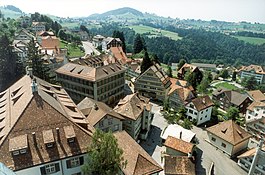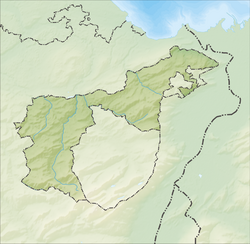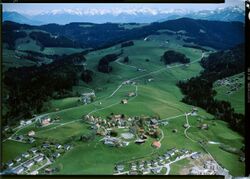Trogen
Topic: Place
 From HandWiki - Reading time: 4 min
From HandWiki - Reading time: 4 min
Trogen | |
|---|---|
 View of Trogen from the church | |
| Coordinates: [ ⚑ ] : Template:Swiss populations data CH-AR) 47°24′N 9°28′E / 47.4°N 9.467°E | |
| Country | Switzerland |
| Canton | Appenzell Ausserrhoden |
| District | n.a. |
| Area | |
| • Total | 10.01 km2 (3.86 sq mi) |
| Elevation | 903 m (2,963 ft) |
| Population (December 2008) | |
| • Total | 1,688 |
| • Density | 170/km2 (440/sq mi) |
| Time zone | UTC+01:00 (Central European Time) |
| • Summer (DST) | UTC+02:00 (Central European Summer Time) |
| Postal code(s) | 9043 |
| SFOS number | 3025 |
| Surrounded by | Altstätten (SG), Bühler, Gais, Oberegg (AI), Rehetobel, Speicher, Wald |
| Website | www SFSO statistics |
Trogen is a municipality in the canton of Appenzell Ausserrhoden in Switzerland . The town is the seat of the canton's judicial authorities.
History
The first mentioning of Trogen was in 1168 (Trugin). The name Trogen refers to a number of fountains (Trögen) which is reflected in the coat of arms. In the 18th century the village was dominated by the local Zellweger family which enjoyed success with textile production and trade. The family established the grammar school (Kantonsschule) in 1821.
Geography
File:ETH-BIB-Trogen-LBS H1-012165.tif Trogen has an area, (As of 2006), of 10 km2 (3.9 sq mi). Of this area, 50.9% is used for agricultural purposes, while 41.1% is forested. Of the rest of the land, 7.8% is settled (buildings or roads) and the remainder (0.2%) is non-productive (rivers, glaciers or mountains).[1]
Demographics
Trogen has a population ((As of 2008)) of 1,688, of which about 7.7% are foreign nationals.[2] Over the last 10 years the population has decreased at a rate of -15.2%. Most of the population ((As of 2000)) speaks German (92.9%), with Serbo-Croatian being second most common ( 2.0%) and Italian being third ( 0.9%).[1] (As of 2000), the gender distribution of the population was 50.3% male and 49.7% female.[3] The age distribution, (As of 2000), in Trogen is; 130 people or 7.0% of the population are between 0–6 years old. 271 people or 14.5% are 6-15, and 149 people or 8.0% are 16-19. Of the adult population, 80 people or 4.3% of the population are between 20–24 years old. 502 people or 26.9% are 25-44, and 452 people or 24.2% are 45-64. The senior population distribution is 186 people or 10.0% of the population are between 65–79 years old, and 97 people or 5.2% are over 80.[3]
In the 2007 federal election the FDP received 66.8% of the vote.[1]
In Trogen about 74.8% of the population (between age 25-64) have completed either non-mandatory upper secondary education or additional higher education (either university or a Fachhochschule).[1]
Trogen has an unemployment rate of 1.46%. (As of 2005), there were 62 people employed in the primary economic sector and about 34 businesses involved in this sector. 76 people are employed in the secondary sector and there are 20 businesses in this sector. 751 people are employed in the tertiary sector, with 86 businesses in this sector.[1]
The historical population is given in the following table:[3]
| Historical population | ||
|---|---|---|
| Year | Pop. | ±% |
| 1980 | 1,853 | — |
| 1990 | 2,042 | +10.2% |
| 2000 | 1,765 | −13.6% |
| 2005 | 1,751 | −0.8% |
| 2007 | 1,693 | −3.3% |
Heritage sites of national significance
Several buildings in the village core, the Protestant church of 1782, the refectory with the cantonal library, the 1805 town hall and the two Zellweger palaces (Doppelpalast / Fünfeckpalast) are listed as heritage sites of national significance.[4]
Sights
Trogen is dominated by the local mountain Gäbris. The village is well known for the Pestalozzi Children Foundation's children village which was built in the 1940s.
Weather
Trogen has an average of 155.1 days of rain per year and on average receives 1,644 mm (64.7 in) of precipitation. The wettest month is July during which time Trogen receives an average of 209 mm (8.2 in) of precipitation. During this month there is precipitation for an average of 14.2 days. The month with the most days of precipitation is June, with an average of 15.4, but with only 203 mm (8.0 in) of precipitation. The driest month of the year is January with an average of 86 mm (3.4 in) of precipitation over 14.2 days.[5]
Transport
Trogen is linked to the city of St. Gallen by the Appenzell–St. Gallen–Trogen railway, a narrow-gauge road-side railway line. The line operates two trains per hour throughout the day, with four trains per hour during peak periods. The journey from St. Gallen to Trogen takes 25 minutes.[6]
Notable people
- Mark Staff Brandl (* 1955), artist and art historian, lives in Trogen
- Wangpo Tethong (born 1963), Swiss-Tibetan activist, writer, spokesperson of Greenpeace Switzerland and member of the 15th Tibetan Parliament in Exile.[7]
References
- ↑ 1.0 1.1 1.2 1.3 1.4 Swiss Federal Statistical Office accessed 17-Sep-2009
- ↑ Brief Statistics for the half-canton (in German) accessed 15 September 2009
- ↑ 3.0 3.1 3.2 Appenzell Outer Rhodes website (in German) accessed 15 September 2009
- ↑ Swiss inventory of cultural property of national and regional significance 21.11.2008 version, (in German) accessed 17-Sep-2009
- ↑ "Temperature and Precipitation Average Values-Table, 1961-1990" (in de, fr, it). Federal Office of Meteorology and Climatology - MeteoSwiss. http://www.meteoswiss.admin.ch/web/de/klima/klima_schweiz/tabellen.html., the weather station elevation is 945 meters above sea level.
- ↑ "St. Gallen–Speicher–Trogen". Bundesamt für Verkehr. http://www.fahrplanfelder.ch/fileadmin/fap_pdf_fields/2014/859.pdf.
- ↑ Phuntsok Yangchen (2010-11-24). "European Chitue Candidates". tibetanpoliticalreview.org. http://www.tibetanpoliticalreview.org/project-updates/europeanchituecandidates.
External links
- Official Page (in German)
- Pestalozzi Children Foundation
 KSF
KSF




